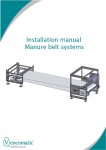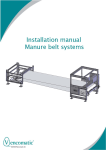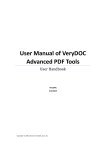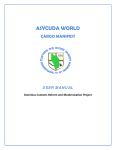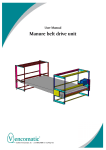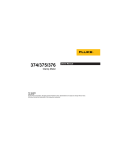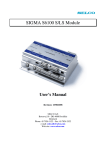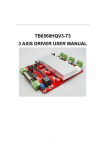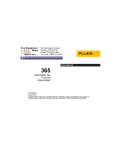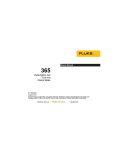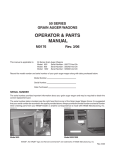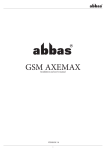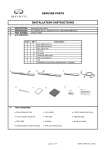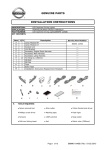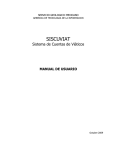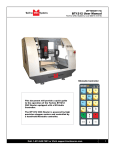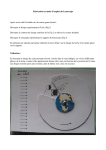Download Mechanic Manual Driveunit D 30-01-09
Transcript
Mechanic manual Manure Belt System. First of all, the mechanic must be fully informed about the User Manual. Installation: 1. Check the delivered drive and return units. a. The drive unit (fig1,detail A): Are all parts mounted? Can you move the bearing plates (fig1, detail A, no 8) freely, is there enough clearance on the lock nuts? (fig1, detail A, no 6+7) Can you move the side plate at the non-motor side and is the motor side bolts all tight? b. The return station (fig1, detail B): Are all parts mounted? Will the cage roller (fig1, detail B, no1) remove the dirt when you rotate it in the right direction? If not, swap the cage roller end for end. The auger flighting inside should move material to the outside edges where it will fall out of the system. 2. Welding the belts, adjusting the Return Unit (R.U) and the Tension Unit (T.U.) in the Drive Unit (D.U.) a. Welding a belt. Take care! When you weld a belt, keep the distance between the sideplate and the frame leg roughly 100 mm (4”).( size “x “ fig 8) Otherwise there is not enough space for the small scrapers (n° 2 fig B) that are in front of the cage roller. Take care, the belts will shrink and grow in length depending on the temperature and the length of the house. Remind that a belt will shrink when it is getting colder in the house. Be sure to mount the small belt plates (art.n°. 276185 of 3000200621) and bend them a little by hand. This will prevent cutting the belt.(fig 2) fig 2 Preparations: • • • • • • • Leave the springs in the T.U. Pull the belt via the R.U. into the section, first the bottom part. (fig 3) the distance between the sideplate and the leg must be roughly100 mm (4”) (fig 8) Disconnect the turning plate in the D.U. and move this upwards as much as possible. Loop the belt through the T.U. and the D.U. (fig 4) reposition the turning plate and adjust this part. (See chapter 3c) Pull the upper part into the R.U. (fig 5) Tense the belt by hand so the belt is as straight as possible. (Do not use the motor) Take care. The R.U. piece must be under the D.U. piece. Weld the belt as prescribed in section B.(fig 6) After the welding, tension the belt as prescribed in the next chapter and after this adjust the small cageroller scrapers. b. The welding: When overlapping the belts for welding, put the belt coming out of the sections as the bottom belt. Remove any sharp edges so nothing can hook when the belt is running. Put the other piece over the “section part” and overlap them 3 meters. (10 feet). Keep both belts aligned and square with each other-this is very important! Keep the joint above the turning plate. (fig1, detail A, no 2) You can weld here with a sonic welder without using an extra piece of sheet metal or wood for backing.. Tack weld the belts with a few welds. Keep the overlap 5 cm.(2”) After welding, cut off the excess.(fig 7) fig 7 Imported things; Keep both parts aligned. The temperature of the house and belts must be 15°C (59°F) or higher. So, don’t store the belts outside. After welding don’t run the belts for 4 to 6 hours. The welds must crystallize (cure) Of course this is not always possible. Adjusting the R.U. (preload of the belt) How tight must the belt be adjusted? Often they are too tight. Remember this is not a conveyor belt. Drive comes from the pressure system in the drive unit, NOT from overall belt tension! A new belt (not running and without manure) is adjusted when the spring tension roller (fig1, detail A, no 10) in the T.U is somewhere in the middle of the slot. ( fig. 9 and 10) When the belt runs for the first time it will stretch a little. After this first run the tension (slack adjustment) must be checked. (and adjusted, if necessary) c. Check the adjustment of the T.U. The scraper on the tension roller is factory set, but please double check this. Also check the tension of the springs, they must be the same on both sides. See the screw eyes. fig 9 fig10 3. The turning plate (fig1, detail A, no 2). The turning plate has a double function. a. First: Preventing that a loop in the belt (fig1, detail A, no 11) gets stuck between the belt itself and the drive roller – a “double wrap”. (fig1, detail A, no 3). The T.U. should prevent this but when the belt is not adjusted correctly, this is an extra safety. b. Second: On the ends of this part are two, stainless steel scrapers. These parts keep the drive roller clean. They prevent that manure what, in spite of the two plastic guiding plates, (fig1, detail A, no12) comes between the belt and the drive roller can build up on the drive roller. When this occurs, the diameter of the drive roller will increase and the scraper (fig1, detail A, no 4) will not clean the belt completely. Only the edges of the belt will be clean and the important middle part will stay dirty. The rubber traction strips on the pressure roller (fig1, detail A, no1) will loose all traction and the belt will not run anymore. This is a common failure, so give it extra attention. c. Adjusting the turning plate after welding the belts. The two stainless steel scrapers must not touch the drive roller. If they touch, this will generate a horrible, squealing sound when you run the belt and it will scare the birds. Always keep a small gap between the scrapers and the drive roller. fig11 4. Adjusting the pressure roller and middle pressure point(fig1, detail A, no 13). a. The function of the pressure roller is to press the belt against the drive roller and, even more important, to pull the belt firmly around the drive roller. That’s why the circumference speed is 4% more. This also helps to steer the belt. (The rubber cams are not at the ends of the roller so the drive roller will act like a pair of conical (convex) pulleys) b. If the pressure roller is dirty ( wet manure), it will not function correctly, the traction is lost and the belt will slip and stall, therefore it is very important to keep this roller and its rubber traction strips clean. Small scrapers (fig1, detail A, no 5) keep the traction strips clean. After running the belt this should be checked and cleaned. c. Adjusting the pressure: The pressure is adjustable through three points: a red spring at each edge and a center pressure block. The tension must be the same at both ends so it is best to build up the pressure evenly, so adjust both sides evenly, step by step. When you tighten first one side and than the other side the risk of an outbalance pressure roller is very high. Always check the gap between the bearing plates and the side plates. (In the latest models small center points are punched in to help as a reference measurement)(fig12) ( fig12 d. The middle pressure point (fig1, detail A, no13) (when delivered) is already adjusted in the factory but can be adjusted if necessary. When adjusting or re-adjusting this device, always be sure that the pressure on the pressure roller is even on both ends and the position is, as described in fig13. fig 13 5. Adjusting the pressure roller scrapers (fig1, detail A, no 5): a. Adjust the scrapers as close as possible without touching the rubber traction strips, especially the older, glued types of pressure rollers.(fig14) fig14 b. Later models have a different device with springs, no adjustment needed.(fig15) fig15 6. Don’t forget to lubricate and adjust the drive chain tension. Explanation the customer / user: Start by making it clear that the Manure belt drive system is not a typical conveyor belt and should not be treated like one. A conveyor belt is often equipped with a rubber belt and this will act like a big rubber band. A conveyor belt needs a high preload to work. When this conveyor belt stalls, the preload must be increased at the return side. The traction will be more and the belt will run again. This is the big difference with a manure belt drive system. The PP belt is not rubber but acts more like a sheet metal plate. The preload (slack adjustment) should be as little as possible, just enough to cope with the stretch when running the belt. When the belt stalls, increasing the preload will not work. The cage roller and the rollers in the T.U. will bend (and probably be damaged) and the resistance to the belt running will increase. The forces on the belt will be tremendous. Since the force on the belt is concentrated on the middle part of the belt, (where the rubber traction strips are mounted) the material in the middle part will be overstretched. At both ends this will not appear so the belt deforms and the only way the stretched material can go is upwards. If you overstretch the belt even more, the belt will run start to pull to the center and overlap. This belt is now permantly damaged. Always refer to the User Manual to the customer/user while doing your explanations. In this User Manual steering, tensioning and maintenance are clearly described but explain him again that he can only move the carriage on the non-motor side. The motor side is locked in place. (In case of an emergency Vencomatic personnel can remove this blockage and steer on this side. Always check the tension of the drive chain when you do this) Tell the customer/ user that in particular when steering the belt a side plate will move towards him when he tightens the nut, but will not go backwards when he loosens the nut. When he runs the belt, after adjusting, the side plate will move backwards most of the time (because of the force on the belt) but not always. Sometimes he must help it with a crowbar or similar tool.(fig16) fig16 What to do when a belt stalls (and what not to do!): When a belt stalls never increase the preload at the slack adjuster. When the belt ran okay before, find out why it stalls now. Possible causes: • Too much manure on the belt. Too much weight. Too wet because of a leaking drinking system, poor ventilation in colder seasons. It is also possible the manure level is too high and drags on the slat bars. The resistance will be very high. • The rods that support the returning (lower) belt are very dirty. Dried manure builds up and squeezes the belt between the dry manure and the tubes supporting the top belt. This happens often when the scrapers are not cleaned and the belt is dirty. • One or both rollers in the T.U. is damaged or is out of round. • The cage roller is damaged or will not rotate anymore. Check why! • Are the keys present in the keyways from the grey plastic sprockets? • Temperature dropped, the belts have shrunk, but no slack adjustment to reduce the belt tension has been made. • The scraper does not clean the belt. • Another cause, something is holding the belt back. When you checked everything and did not find a cause, you may increase the tension of the pressure roller. (the red compression springs) Reminder: keep the tension on both sides even. When a middle pressure point is installed you may increase the pressure a little. Never increase the pressures more than necessary. Instruct the customer again to decrease the tension at the R.U. when the birds go out of the house and the belts will shrink. This is easy to forget! Anthony Bal Mechanical Engineer Vencomatic, The Netherlands ©2008 Vencomatic b.v.











